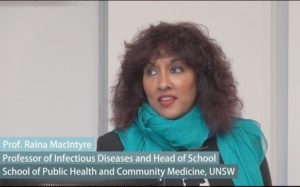Insights from Prof Raina MacIntyre on COVID-19

The Latest from Science: Insights from Prof Raina MacIntyre on COVID-19
Here are Professor’s following comments in an interview with Paul Richards:
On elimination: So what we aim to do with disease control measures is to reduce the reproductive number or R0 below one. And that’s what the 10 cases giving rise to 5 new cases indicates that the reproductive number is below one, so one case can’t give rise to more than one case. And if that’s the case then like New Zealand, we should be aiming for elimination. Now in terms of infectious diseases, elimination doesn’t mean you’d get rid of the disease altogether. It means that you stop transmission within the local community and you may still get imported cases. A great example is measles. Australia has achieved elimination of measles, according to the WHO. But we still see outbreaks of measles, but they are related to importation from travel and they die out. They cannot be sustained and they don’t take off in the whole community.
On closing schools: So there’s a bit of risk in making assumptions when we don’t have the data. With every other respiratory transmissible infectious diseases, we know that they spread most intensely in children, young people and young adults. So I would expect that it wouldn’t be very different in this case. We do know that children are less likely to get symptomatic illness, but they are probably just as likely to get infected and to be the vectors of silent transmission in the community. You can’t just lock up old people and put little kids in a bubble, unless we want to take all the children and put them in a camp somewhere on their own. Children live with adults, they live in families. They sometimes have grandparents in the home. And the most intense transmission happens in the household. So we saw that data come from China, that over 70 per cent of all the infections arose inside the household. So if you’re allowing kids to mix in thousands in some cases, they could be bringing infection back home into the family, which is the highest risk of transmission.
On a vaccine: So a coronavirus is not the easiest virus to make a vaccine against. Something like measles is the ideal virus to make a vaccine against because exposure to the virus or to antigens on the surface of the virus will give you long-lasting, lifelong immunity, high levels of immunity. So you get your measles shot, you’re generally protected for life. That’s not the case with coronaviruses. The immunity is not long lasting. It’s certainly not lifelong for any of the seasonal coronaviruses or the SARS and MERS coronavirus. What we know from studies of those viruses is that you can get reinfected and the antibodies that give you the protection last somewhere between 16 months to three years, maybe six years at the most. So we’re looking at a vaccine that probably we will need some kind of booster dose for or ongoing vaccination maybe, in the way we vaccinate against flu. And we’ve seen something unprecedented happen, is that two vaccine manufacturing giants Sanofi and GSK have actually joined forces, which has never happened before in my lifetime of working in vaccines for 30 years. Never seen that happen before. So that gives me a lot of hope that there’s really a very, very strong and concerted and coordinated effort globally to get some solutions.
On privacy issues around contact tracing apps: So I think in public health epidemics in a crisis like this, we need to do some things that are in the greater good. And they’re in our personal good as well. Because the benefits personally are that you will get information if you’ve been in a place that’s high risk, where there’s been an outbreak, if you’ve potentially been in contact with somebody who is infected. And you can also get information on general areas where there might be outbreaks. And of course the benefit for the health authorities is that they can get a more complete picture of contacts. And contacts of people who are infected are the way that epidemics grow. If you don’t identify everybody who is a contact, then you get silent transmission and the epidemic grows. [The way] out of this crisis because the modelling is only as good as the data.
This interview is credited to The Australian Academy of Science
To help people understand the changing situation and make decisions relating to COVID-19, the Australian Academy of Science is producing articles and videos based on the latest available knowledge. This information aligns with advice from the Australian Government Department of Health.
Short URL: https://indiandownunder.com.au/?p=15076
